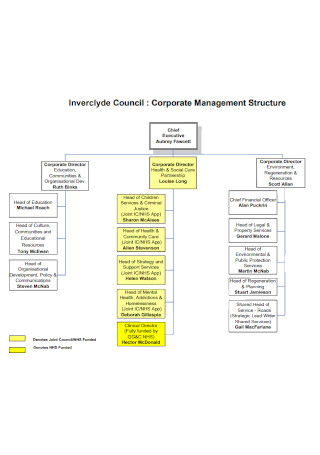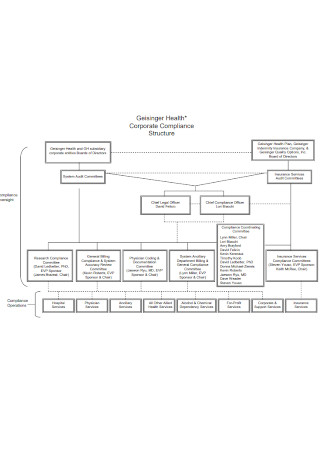Data is a powerful force. It can thrust a company to new heights. It can influence a national election. But its power lies in its presentation. When you consider it, data are…
continue reading
20+ Sample Corporate Management Structure Charts
-

Corporate Governance Structure Chart
download now -

Sample Corporate Management Structure Chart
download now -

Corporate Motors Management Structure Chart
download now -

Company Financial Structure Chart
download now -

Corporate Business Structure Chart
download now -

Project Management Structures Chart
download now -

Basic Corporate Structure Chart
download now -

Company Organizational Structure Chart
download now -

Corporate Management Team Structure Chart
download now -

Corporate Secretary Management Structure Chart
download now -

Simple Corporate Governance Structure Chart
download now -

Corporate Council Management Structure Chart
download now -

Corporate Director Management Structure Chart
download now -

Standard Corporate Structure Chart
download now -

Health Organizational Structure Chart
download now -

Corporate Group Structure Chart
download now -

Corporate Compliance Structure Chart
download now -

Corporate Board Structure Chart
download now -

Legal Corporate Structure Chart
download now -

Formal Corporate Structure Chart
download now -

Sample Corporate Business Organization Chart
download now
What Is a Corporate Management Structure Chart?
A corporate management structure chart is your organization’s typical corporate organizational chart. It marks the graphic diagram of a company’s organizational structure such as what every employee does, whom to report to, and how business decisions take place. And it is through these charts that you get the introduction of a company’s team from the manager down to the rest of the staff members.
Why Are Corporate Management Structure Charts Important?
Are you in doubt whether to make or not to make a management structure chart for your business? A chart is more than just figures and symbols. What they represent matters the most. And here are some reasons that prove why you should consider corporate management structure charts:
To Visually Display Hierarchical Management
A business where everyone is a leader gets chaotic, especially when leaders have different opinions and no one is willing to step down as a follower. At the same time, having all workers as followers is just as bad, considering that no one would be spearheading in accomplishing common goals. A management plan is crucial. And what better way to present the hierarchy in management than to display it using corporate management structure charts? This way, corporate governance is practiced.
To Familiarize the Team and Their Roles
If you need the quickest way to understand and familiarize everyone in a company and their positions in just a look, then simply refer to a corporate management structure chart. Through analyzing the chart, you learn about the team and their roles within minutes. And that is better if it is too time-consuming to interview each team member about their responsibilities. Also, corporate structure charts are helpful for startups to quickly highlight their positions and tasks.
To Show How a Business Forms Its Goals
A clear organizational structure in a company’s management proves how capable a business is in outlining its goals and objectives. Rather than not having any strategic plan towards corporate management, a corporate structure shows how prepared your company and its team as a whole is. So be sure to clearly label your corporate management structure chart from the board directors, officers, down to shareholders.
To Appeal to Investors, Stakeholders, and Clients
What also makes a corporate management structure chart special is how it appeals to investors, clients, or stakeholders. When these people see your chart and analyze its diagram, they can understand how your business works. And it even attracts them the most if the chart outlines how your business generates profits. Once you fully keep them interested, these people would be obliged to trust your company and work with you in long term.
The Nine Types of Corporate Organizational Structure
Indeed, a company’s corporate structure is crucial for success. But did you know that there are many types of corporate organizational structures you can apply? So for your next corporate management structure chart, here are nine types of organizational structures you may choose from:
The Three Parts of a Corporate Structure
There are three building blocks of a corporate structure. These are the board of directors, corporate officers, and shareholders. But who exactly are they? In this section, learn about the three main parts of a corporate structure, aka what completes your corporate management organizational structure chart.
Board of Directors
The heads of an organization are categorized under the board of directors. And they work to report to shareholders, ensure business plans are going exactly as planned, monitor if laws are regulated, set the business goals and budget, and even hold regular meetings. And these board directors mostly consist of the chairperson (the highest part of the business pyramid), the inside directors (the ones usually in chart of budgeting), and the outside directors (the ones assisting the inside directors).
Corporate Officers
Also a crucial part of the corporate structure is the corporate officer. These officers are appointed by the board of directors yet they still handle upper management tasks. And corporate officers should always watch out for the organization’s interests. Also, there are four categories of these officers which are the chief executive officer (CEO) or president, chief operations officer (COO) or vice president, chief financial officer (CFO) or treasurer, and the secretary.
Shareholders
The proprietors or shareholders basically the owners of a company. However, you don’t expect them to be in the business every day. Also, it is possible for an enterprise to be own by various shareholders so they get shares each, particularly stock shares. Nonetheless, the shareholders are critical in the corporate structure to create business decisions. They are also in charge of disposing assets, considering a business partnership agreement, changing bylaws, and electing the board of directors.
How to Make a Corporate Management Structure Chart
Creating a corporate management structure chart is not that difficult, especially when you already went through an enlightened journey from the corporate management structure chart’s definition, importance, types of organizational structures, to the parts of a corporate structure. So for the main event, here are steps in formulating the corporate management structure chart itself:
Step 1: Study Your Organization
You won’t be able to label and categorize the hierarchy or organizational structure of your company without familiarizing your company as a whole. So you have to undergo industry analysis first. This is the time to review the basic documents and other references that help you set the corporate management structure. Rest assured, making the corporate structure chart comes off easy when your knowledge is refreshed with what to input there.
Step 2: Leverage a Sample Chart Template
Free editable, printable, and downloadable corporate management structure chart templates are waiting for you above this article. So be sure to use a sample template of your choice so you never need to create these charts out of nothing. Premade templates make it easier for you to complete your chart. Also, you may optimize loads of other related samples such as an organogram template, timeline chart template, detailed organizational chart template, and many more.
Step 3: List Down Corporate Structure’s Building Blocks
Can you recall the three parts of a corporate structure, as discussed earlier? Besides naming the lower-level employees and customers in your corporate organizational structure, be sure to incorporate the board of directors, corporate officers, and shareholders as well. Those three are the main building blocks of the company management structure anyway. In labeling the chart, you simply list each of their name, job position/task, and department.
Step 4: Use the Proper Type of Organizational Structure
Most importantly, identify the type of organizational structure that works appropriately for your corporate management structure chart. Whether you use the functional structure, process-based structure, product-based structure, matrix structure, or any other example, achieve the right set of data to input in your chosen type. And you can also insert more elements to your chart such as drawings, legends, and additional information.
Step 5: Focus on Presenting Data Easily, Briefly, and Visually
The most important step is to ensure your chart properly presents the data intended to be displayed. Also, take note on how charts are more focused on visual details so there is no need to write in long complete sentences while labeling the shapes and figures inside. You mostly write names and roles only in a corporate structure. So keep your chart concise and easy to read until it creates a smooth flow like a visual business report.
FAQs
What are the three main things to achieve in an organizational structure?
Organizational structures should at least identify the chain of command, span of control, and centralization.
Can one person fill all the roles in a corporate structure?
Yes, there are states that accept one person to handle a variety of roles in a corporate structure. But you need to be realistic that having more than one role in a company structure, especially for a big company, is very challenging. Also, companies with lots of shareholders would likely need more than one board of director.
What are the standard business types?
The common business types are sole proprietorship, partnership, limited liability partnership, limited liability company, corporation, and S-corporation.
They say that deciding your company’s corporate management structure is like buying a new car or considering a house purchase agreement. It is a big investment that you would not want to jeopardize; otherwise, you would lose it. Just like a house and a car, you would need the corporate structure to be properly built and well-maintained. So be sure to start strong with your business management structure using sample corporate management structure chart templates as your reference. Download a template now!

